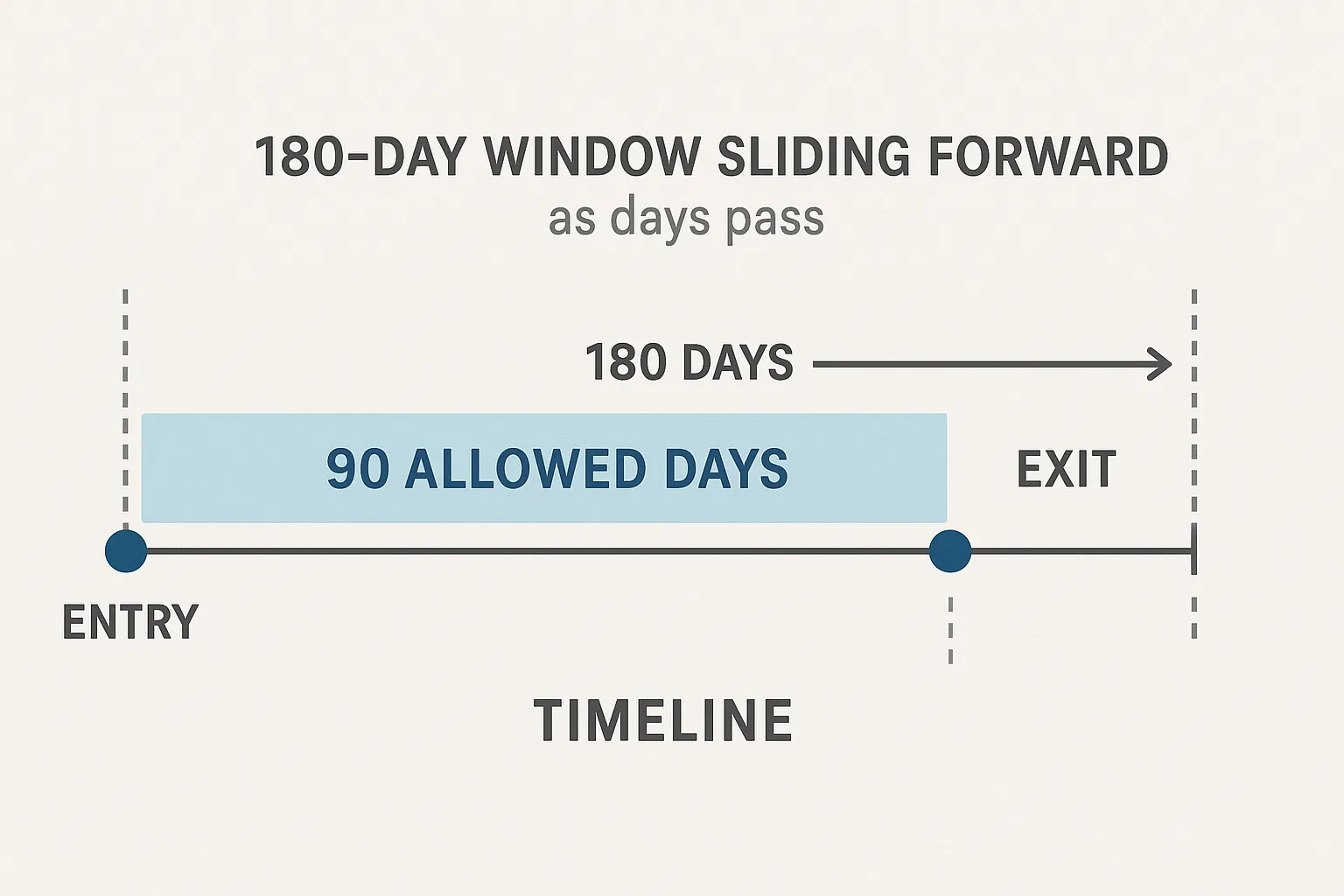Overstay Calculation: Counting Schengen Days Like a Pro

Strolling between Paris, Barcelona and Rome feels delightfully border-free—until you realise you have blown past the 90 days you were allowed to stay in the Schengen Area and a border guard slips an « EXCEEDED STAY » stamp into your passport. A single miscount can trigger hefty fines, entry bans or an Obligation de Quitter le Territoire Français (OQTF). Mastering the rolling 90/180 rule is therefore essential for every non-EU traveller, digital nomad, seasonal worker and even residence-permit holder who still takes weekend breaks in neighbouring countries. This guide will teach you how to count Schengen days like a pro, avoid painful surprises, and know what to do if you are already in the red.
1. The 90/180 Rule in Plain English
The rule is set out in Article 6 of the Schengen Borders Code and Article 12 of the Visa Code:
- You may spend up to 90 days in any 180-day period in the combined territory of the 26 Schengen states if you hold a short-stay visa or are visa-exempt.
- The 180-day "reference period" is rolling. Each day you are inside Schengen, you must look back 179 days (plus the current day) and make sure the total of all stays does not exceed 90.
- Day of entry and day of exit both count as full days.
If you hold a French residence permit, time spent in France is not limited, but your days in the other 25 Schengen countries still count toward the 90-day cap (see our guide "Traveling Inside Schengen with a French Residence Permit" for the basics).

2. Why Counting Is Harder Than It Looks
- Multiple trips quickly add up and overlap.
- Partial days (late-night flights) still count as full days.
- Entry stamps may be missing when you cross an internal Schengen border by train or car.
- From late 2025 the EU Entry/Exit System (EES) will log each crossing automatically; errors in its database will be harder to dispute.
3. Manual Calculation Step by Step
Imagine Maria, a Brazilian freelancer, made the following trips in 2025:
| Trip | Entry | Exit | Days Spent |
|---|---|---|---|
| 1 | 1 Feb | 28 Feb | 28 |
| 2 | 15 Apr | 30 Apr | 16 |
| 3 | 10 Jun | 19 Aug | 71 |
Total days would appear to be 115—well beyond the limit—but we must use the rolling window.
- Pick any day inside her current stay (e.g., 19 Aug).
- Count back 179 days to 23 Feb.
- Add all days between 23 Feb and 19 Aug: this includes the last 6 days of Trip 1 (23–28 Feb), all of Trip 2 (16 days) and all of Trip 3 (71 days) = 93 days. Maria will overstay on 18 Aug.
A simple test: after every new entry, add the length of that trip to the total number of days spent in the previous 179 days. If the sum exceeds 90, you cannot enter—or must leave early.
Quick Excel Formula
If you keep a list of entry and exit dates in columns A and B, you can compute cumulative days with:
=SUMPRODUCT(--(B$2:B$100>=B2-179),--(A$2:A$100<=B2))
Any result above 90 flags a problem.
4. Digital Tools to the Rescue (With Caveats)
- EU Schengen Calculator (European Commission) – official and free but requires manual input. Check it here.
- Schengen90 App (iOS/Android) – scans passport stamps, useful on the go.
- Excel/Google Sheets templates – ideal for complex itineraries and seasonal workers.
Common pitfalls:
- Apps cannot see unstamped land borders; you must enter those dates yourself.
- Official calculator ignores bilateral visa waiver agreements (see below).
5. Special Scenarios That Trip People Up
- Residence-Permit Holders – Days in France are unlimited, but a weekend in Spain counts. Frequent travellers should keep a log.
- Bilateral Visa Waivers – Certain nationals (e.g., U.S., Canada, Australia) enjoy extra visa-free days in specific countries outside the Schengen quota (e.g., 90 additional days in Poland). These days still matter if you re-enter Schengen elsewhere—seek legal advice before relying on them.
- Seasonal Workers – You juggle the 90/180 Schengen limit plus France’s six-month-per-12-month cap for APTs. See our article on "Seasonal Worker Re-Entry".
- Airport Transit (Category A visa) – Staying in the international zone does not count, but exiting into Schengen for an overnight hotel does.
- Multiple Passports – The limit applies per person, not per document. Mixing passports will not fool EES.
- Unstamped Exits – Always keep boarding passes, toll receipts or phone geolocation history to prove you left when your passport does not show an exit stamp.
6. Penalties for Overstay in France and Beyond
| Overstay Length | Typical French Sanction | Possible Schengen-Wide Effect |
|---|---|---|
| 1–3 days | Warning or €200 fine | Border note, future scrutiny |
| 4–30 days | Fixed penalty (€200–€500), OQTF risk | Flag in SIS, future visa refusal |
| >30 days | OQTF + ban of up to 3 years | Schengen re-entry ban |
Data source: Ministère de l’Intérieur circular INTK2312990C (Jan 2024) and CESEDA Art. L.511-1.
7. What If You Are About to Overstay?
- Apply for an extension at the prefecture before day 90 citing force majeure (health, cancelled flights). Success rates are low but higher with documented proof.
- Leave to a non-Schengen country (UK, Morocco, Serbia) and reset your rolling window once your count drops below 90.
- Switch status: If you qualify for a long-stay visa or residence permit, file the request while still legal; ImmiFrance can help evaluate fast-track options.
Already Overstayed?
- Gather evidence of exits and mitigating circumstances (medical, family emergency).
- If you receive an OQTF, act within 30 days (or 15 under fast-track) – read our guide "OQTF Explained".
- Voluntary departure with proof can shorten future bans.
8. Pro Tips to Keep Your Count Under 90
- Log every entry and exit in a spreadsheet or note-taking app.
- When planning travel, use the "forward count" feature of the EU calculator to test future itineraries.
- Keep digital backups of tickets and hotel invoices; EES errors will happen.
- Set calendar alerts 10 days before you are due to hit 90.
- If you live in France, consider a multi-year residence permit to avoid repeated short stays in neighbouring countries counting against you.

Frequently Asked Questions
Does the 90/180 rule restart on 1 January each year? No. The window constantly rolls forward; 180 days is always counted backward from today.
Do border officers check every calculation? Increasingly, yes. From late 2025 the Entry/Exit System will display your remaining days in seconds, leaving little room for negotiation.
I have a French récépissé while my card is being renewed—can I travel freely? Inside France, yes; outside you still face the 90/180 limit and airline desk issues. Read our guide on residence-permit renewal during overseas travel.
What if my passport lacks an entry stamp? The burden of proof is on you. Keep boarding passes or digital traces to show when you entered.
Can ImmiFrance help if I already overstayed? Yes. We offer case diagnostics, appeal templates, and lawyer referrals to tackle OQTFs or negotiate voluntary departures.
Avoiding an overstay is far easier—and cheaper—than fixing one. If you are unsure about your remaining Schengen days, planning a complex multi-country itinerary, or facing penalties after a miscount, let our experts crunch the numbers and craft a compliance strategy tailored to your situation.
Book a 30-minute "Schengen-Day Check-Up" with an ImmiFrance adviser today and travel with confidence.
